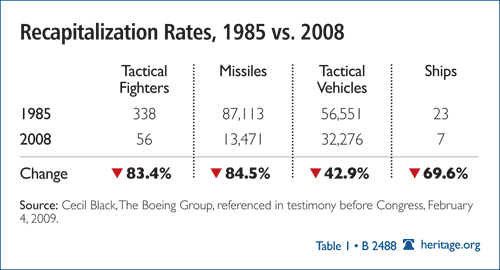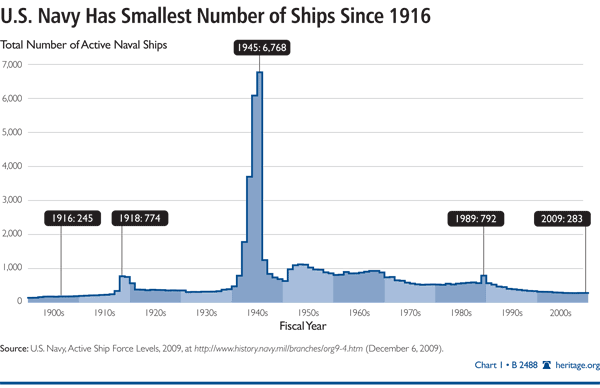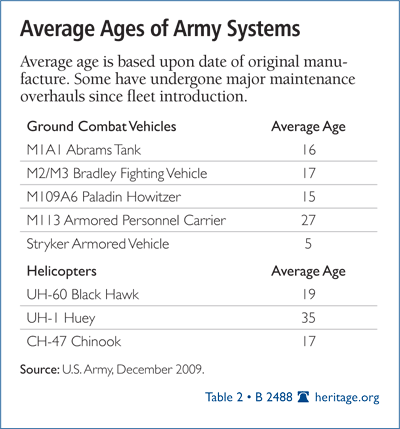Abstract: A decade of military conflict and two decades of underinvestment have left the U.S. military too small and inadequately equipped to answer the nation’s call today, much less tomorrow. In July 2010, a bipartisan commission warned of a coming “train wreck” if Congress does not act quickly to rebuild and modernize the U.S. military. To meet tomorrow’s needs, the tools of national security must be strengthened quickly for the U.S. to help to stabilize the international environment and keep U.S. citizens safe and free, while ensuring America’s economy can prosper and grow. There is no quick or easy fix. Meeting the military’s full modernization requirements will “require a substantial and immediate additional investment that is sustained through the long term.” However, the price of U.S. weakness will be greater in the long run.
This summer, a bipartisan, blue ribbon commission established by Congress[1] came to a stark conclusion about the worrisome state of America’s military:
The aging of the inventories and equipment used by the services, the decline in the size of the Navy, escalating personnel entitlements, overhead and procurement costs, and the growing stress on the force means that a train wreck is coming in the areas of personnel, acquisition, and force structure. In addition, our nation needs to build greater civil operational capacity to deploy civilians alongside our military and to partner with international bodies, the private sector, and non-governmental organizations in dealing with failed and failing states.
The potential consequences for the United States of a “business as usual” attitude towards the concerns in this Report are not acceptable. We are confident that the trendlines can be reversed, but it will require an ongoing, bipartisan concentration of political will in support of decisive action.[2]
The Quadrennial Defense Review Independent Panel has good reason to be concerned over the Pentagon’s 2010 Quadrennial Defense Review (QDR),[3] the first under President Barack Obama. (The Honorable James Talent served as a congressionally appointed commissioner on the panel.) Over the past two decades, the size of the U.S. military has declined by one-third. Conversely, each major defense strategy since the early 1990s has emphasized new missions for the U.S. armed forces without providing substantial additional resources. Strained, aging platforms have reached the point at which they cannot achieve desired mission outcomes. The men and women in the U.S. military are “operating at maximum operational tempo, wearing out people and equipment faster then expected, using the reserve component more than anticipated, and stressing active duty personnel in all the military services.”[4] There is no quick fix to meeting full modernization requirements, and it will “require a substantial and immediate additional investment that is sustained through the long term.”[5]
Congress needs to act now to restore and repair the U.S. armed forces after a decade of conflict and two decades of underinvestment in modernization. It should begin by carefully examining the panel’s findings and beginning to implement its recommendations to rebuild the military. As the panel clearly stated, “protecting American lives and property is the most fundamental responsibility of the U.S. government.”[6]
Congress’s Concern About the QDR
Every four years, the Department of Defense issues the Quadrennial Defense Review, its major strategic planning document. The QDR is intended to look forward two decades and delineate how the U.S. will structure its armed forces. The object is to outline threats, military strategy, force structure, and budgetary plans and to establish a road map for defense programs that will prepare for an uncertain future. The 2010 QDR lacked long-term vision and served largely as an analytical justification for current defense plans and programs, including the scaling back of modernization priorities to develop many of the next-generation systems.[7]
As The Heritage Foundation recommended,[8] Congress voted to establish an independent panel to review the 2010 QDR. In July, the panel released its final report, The QDR in Perspective: Meeting America’s National Security Needs in the 21st Century.[9] The panel was co-chaired by William J. Perry, Secretary of Defense under President Bill Clinton, and Stephen J. Hadley, National Security Adviser under President George W. Bush. The panel’s report to Congress was not an ideological document, but rather a baseline statement about U.S. security.
Congress would be wise to carefully examine the QDR Independent Panel’s findings and to begin implementing the recommendations, including the need to increase the size of the U.S. Navy, recapitalize major systems on a one-for-one basis, acquire a next-generation bomber, field new long-range strike systems, and establish a national commission to review military personnel management policies.
The U.S. as Global Leader—Not Policeman
The Independent QDR Panel’s report highlighted the enduring U.S. national security interests, which include:
- Defending the American homeland;
- Assuring access to the sea, air, space, and cyberspace;
- Preserving a favorable balance of power across Eurasia that prevents authoritarian domination of that region; and
- Providing for the global “common good” through actions, such as humanitarian aid, development assistance, and disaster relief.
After analyzing U.S. strategic interests around the world, the report concluded:
There is a choice our planners do not have. As the last 20 years have shown, America does not have the option of abandoning a leadership role in support of its national interests. Those interests are vital to the security of the United States. Failure to anticipate and manage the conflicts that threaten those interests—to thoughtfully exploit the options we have set forth above in support of a purposeful global strategy—will not make those conflicts go away or make America’s interests any less important. It will simply lead to an increasingly unstable and unfriendly global climate and, eventually, to conflicts America cannot ignore, which we must prosecute with limited choices under unfavorable circumstances—and with stakes that are higher than anyone would like.[10]
U.S. safety and security depends on “securing common domains” on, above, and below the high seas, in space, and in cyberspace during times of war and peace. If the United States is not there to protect commerce, and by extension the health of the American economy, threats to the free flow of goods will negatively affect the U.S. and other countries. Maintaining U.S. military presence abroad will also continue to be necessary. Yet the declining U.S. military force structure is threatening the long-standing belief of many allies that the U.S. can enforce its own treaty commitments. Americans should be deeply troubled by U.S. friends and allies’ growing concerns[11] about the U.S. ability to defend its interests around the globe.
As the panel noted, the United States cannot and should not act alone in the world, but effective alliances depend on American leadership, which in turn requires American strength. The U.S. needs to “guide continued adaptation of existing international institutions and alliances and support the development of new institutions appropriate to the demands of the 21st century.”[12] This will be impossible without “global confidence in American leadership and its political, economic, and military strength and steadfast national purpose.” The United States’ ability to promote new alliances, assemble support for policies, and shape the international environment will depend on “sustaining the umbrella of American national security leadership.”[13]
U.S. leadership in the world is also necessary to preserving a favorable balance of power across Eurasia and providing for the “common good” with humanitarian aid, development assistance, and disaster relief.[14]
The Risks Are Growing
To mitigate an increasingly unstable future, the U.S. must acknowledge the greatest areas of foreseeable risk. Policymakers and citizens should know that all types and categories of risk challenging U.S. interests are growing. The report identifies key global trends that will affect America, including:
- Islamist extremism and the threat of terrorism,
- The rise of new global powers in Asia,
- The continued struggle for power in the Persian Gulf and the greater Middle East,
- An accelerating global competition for resources, and
- Persistent problems from failed and failing states.
To date, Islamist extremism and terrorism remain both domestic and international concerns. The greatest risk to the U.S. is that “weapons of mass destruction or the materials and expertise to produce them…find their way into the hands of fanatical, murderous jihadists.”[15] The threat from violent Islamist movements will not go away after combat operations cease in Iraq and Afghanistan. Countering this challenge will continue to demand significant resources from the U.S. government, particularly from the military.
The rising importance of China and India also suggests a shift of power toward the Asia–Pacific region. This shift is occurring as U.S. resources to maintain global presence are shrinking, as is America’s ability to deter, influence, reassure, and shape the decisions of others. The Pentagon’s QDR report virtually ignores China, which indicates a lack of preparation for its dynamic rise. Meanwhile, Iran remains a destabilizing force in the Middle East, and its power will grow as it acquires nuclear and other asymmetric weapons.
Beyond the challenges that defense planners and policymakers can predict are still the unforeseen challenges. History indicates that as states destabilize and as rising powers see weakness among Western-allied democracies, international crime, terrorist safe havens, piracy, oppression, and lawlessness will increase. Such drastic scenarios may seem unrelated, but as the report notes, “the risk we don’t anticipate is precisely the one most likely to be realized.”[16]
Comprehensively Unprepared for the Future
The Pentagon’s QDR does not adequately identify the panoply of risks confronting the United States. Further, the Pentagon’s strategy does not address the elephant in the room: The U.S. military is already too small and its equipment is already too old to fully answer the nation’s call today, much less tomorrow. As Table 1 indicates, the U.S. has largely failed to recapitalize its military in a generation. Consequently, the panel’s report notes the growing gap between what the U.S. military is asked to do and the tools it has to accomplish their missions.
The Independent QDR Panel’s report correctly notes how busy the U.S. military was long before 9/11 and after the fall of the Berlin Wall. For example, the U.S. Air Force has been flying over hostile skies in Iraq for nearly 20 years without a break.
To meet tomorrow’s needs, the tools of national security must be strengthened quickly for the U.S. to help to stabilize the international environment and keep U.S. citizens safe and free, while ensuring America’s economy can prosper and grow. As the panel noted, the military’s equipment is old and therefore unreliable, increasingly out of date technologically, and insufficient in number. In particular, the U.S. Navy is too small and at risk of shrinking further due to budget constraints. (See Chart 1.)
The panel members agreed the Pentagon “should plan for a force structure that gives us a clear predominance of capability in any given situation.”[17] A fleet of at least 313 ships—the U.S. Navy’s current baseline—is the bare minimum size needed to match capabilities to commitments. The panel recommends expanding the Navy to roughly the 346 ships suggested in the 1993 Bottom Up Review. In addition to the growing challenges and need for continued presence and access in Asia, the report also notes the stresses placed on the force over the past 15 years and the additional missions the military has assumed: “[I]t is unlikely that the United States can make do with less than it needed in the early 1990s, when Americans assumed the world would be much more peaceful post Cold War.”[18]
The panel’s report also identified the urgent need to modernize the weapons and equipment inventory of all the services. The Navy needs to begin developing a next-generation cruiser and buy additional submarines. The Air Force needs to increase its deep-strike capability, acquire more long-range platforms, and obtain a new tanker and additional lift capability. The Army needs to recapitalize its inventory of tracked combat vehicles. (See Table 2.)
All of these modernization investments are needed, but the Pentagon has not planned or budgeted for them adequately. The Army has already skipped a generation of modernization in its combat vehicle fleet and is at increased risk each year of further delays. Cyber security remains largely ignored and could become an even greater vulnerability in the future.
The panel’s report acknowledges the need to strengthen the tools of soft power to complement U.S. defenses. For example, to update antiquated guidelines in and across other federal agencies, the President would need to issue a directive that “clarifies interagency roles and responsibilities for ‘whole of government’ missions.”[19] Congress and the President should establish a National Commission on Building the Civil Force of the Future and provide civilian agencies with the proper resources and staff to contribute on a larger scale to stability operations abroad.
However, the panel also recognized that the civilian tools of national power—such as diplomacy, sanctions, effective communications of national intent, and building democracy and economic institutions—can supplement military capability, but they cannot substitute for it. As Iraq and Afghanistan have proven, soft power efforts require time and security to work. They can build on a stable foundation, which only hard power can create.
Conclusion
The findings of the QDR Independent Panel, an ideologically diverse group of defense experts, are a stark warning to Congress and the American people. Unless the panel’s recommendations are taken seriously and Congress immediately begins implementing them, America faces impending disaster. The “aging of the inventories and equipment used by the services, the decline in the size of the Navy, escalating personnel entitlements, overhead and procurement costs, and the growing stress on the force means that a train wreck is coming in the areas of personnel, acquisition, and force structure.”[20]
American strength comes at a price, but weakness also has a price—one that the panel’s report notes “in the long run would be much greater.”[21]
—The Honorable James Talent is Distinguished Fellow in Military Affairs at The Heritage Foundation and served as a U.S. Senator from 2002 to 2007. He also served as a Commissioner on the Quadrennial Defense Review Independent Panel. Mackenzie Eaglen is Research Fellow for National Security in the Douglas and Sarah Allison Center for Foreign Policy Studies, a division of the Kathryn and Shelby Cullom Davis Institute for International Studies, at The Heritage Foundation. She also was a Staff Member of the Quadrennial Defense Review Independent Panel.





